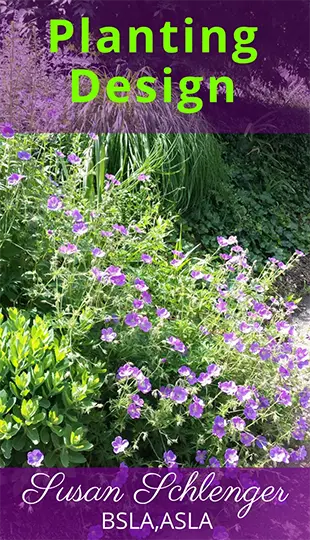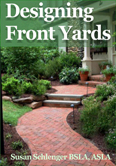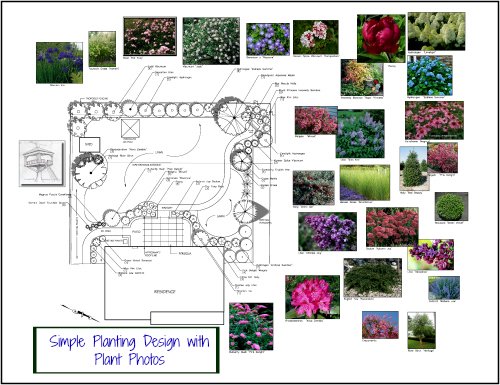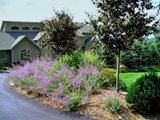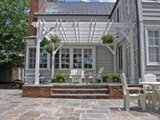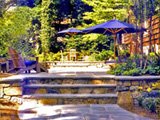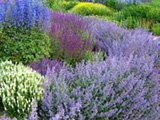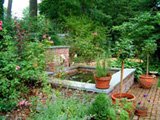Foundation Plantings and Layouts
When designing foundation plantings, I look at the entire picture at first...not just individual plants. And the worst thing you can do is fall in love with so many plants that your design becomes "one of this and one of that"!
Instead, plant in groups and repeat them along your house to create an attractive flow. Read further to see how you select the right plants.
Foundation plantings - Sissinghurst, England.
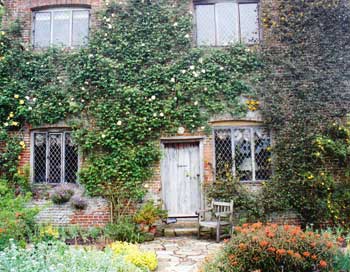
Frame Your House and Create Balance
I always add some taller trees or shrubs at the end house corners. These plants will place your house within a planting framework.
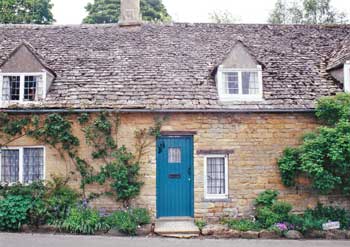
They can also add interest, softness, height, texture, color and so on.
You might use a heavy evergreen tree on one end and one to three ornamental trees on the other end. (Cryptomeria and some Holly hybrids are a couple of the more narrow evergreens.)
You can also consider using one ornamental tree and three tall shrubs, such as Lilacs. There are various trees to use in foundation plantings. Anywhere from one to three landscape trees or shrubs at house corners are typical.
- Place the trees far enough away from the house so that they have room to grow.
- Try to balance the "weights" of the trees and/or shrubs.
- Alter the forms. If you have one tree that has a graceful form on one end, choose another type for the other side of the house...perhaps a more upright, fan-like shape.
- Tree shapes can be conical (similar to a Christmas tree shape), fan-like, columnar, multi-stemmed, oval, etc. Consider the shape when selecting trees.
Depending
on the length of the residence, it's also nice to have a taller plant
near the front door also. I often place this at the far side of the
front steps, just beyond, but near, the walkway. This is quite welcoming
as one approaches the entry doorway as discussed in my book Designing Front Yards
Foundation Shrubs
If you have a long winter where you live, using evergreen shrubs as the first layer for the foundation plants along the house will provide you with winter interest. They keep their green foliage all year long.
This does not mean that all plantings here must be evergreen though. You can add some deciduous plants in too.
Deciduous plants are those that lose their leaves at the end of the season. The foliage grows back in the spring, lasting through spring, summer and fall...not so bad!
You can also create a more natural, wild type garden (even though it's a foundation planting), by using mostly perennials. Oehme van Sweden and Associates is known for this type of garden design with the coined phrase "The New American Garden". They use drought tolerant perennials...and no lawn at all!
Depending on the width of your beds, you can add additional layers of plants.
The second layer might be lower evergreen shrubs such as Juniper, deciduous shrubs, or perennial flowers.
You might want to add a third layer. Plants here should be quite low such as shorter perennials or ground cover. Pachysandra and Vinca are two evergreen ground covers you can use, but they need some shade.
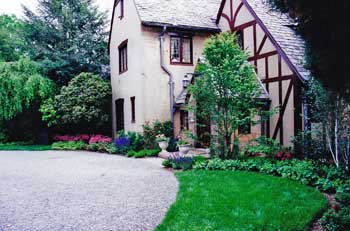
There are also perennial ground covers which provide a lot of texture and color when in bloom. But of course, perennials are not that attractive in the winter time as they die down, only to re-appear in the spring.
You
will have to decide how important the evergreen quality is to you. I
like to plant a mix to get a little bit of everything. I'd hate to give
up some beautiful long lasting flowers. I'll put up with some winter
perennial boredom to have the blooms and color!
Planting Design
- Use foundation plantings in groups of three or more shrubs or perennials.
- Repeat groups for continuity.
- If your home is not that long, you may use all the same shrubs in the background and create color and interest with the other layers.
- You can be whimsical and add a single plant in here and there if you like.
Here is something you may be apt to do...placing matching plants on either side of the front door. Unless you have a very formal setting, this is not necessary. It's much more interesting to be more creative by working with varying plant heights.
Another thing I have seen people do is to place a tall plant in front of a blank wall space. If it lends itself to this, fine. But this is not necessary if the rest of the plantings are designed well. There are other more interesting design ideas for blank walls.
You might consider adding a sculpture,
birdbath, or trellis with vines. How about vines growing on the house?
Some people are horrified at this idea. But think about the plant Boston
Ivy which loses it leaves in the winter and has a lovely branching
pattern! It also has gorgeous fall color!
Foundation Plant Sizes
Along with the typical considerations such as sun and shade conditions, deer problems, soil types, etc., you must also consider tree or shrub sizes. These are not plants that will be out in the open where size may not matter.
When working with foundation plantings, size is very important. Decide what height range you will ultimately want and what width for each of your plants. Choose these plants.
Do
not look at the plant's size now when choosing, but know the plant's
mature size! This is the only way you will not end up with overgrown
plants. That cute little plant can really grow into a monster which
you will ultimately be unhappy with. Be careful not to choose plants
that will grow taller than your windows...unless you want one for a
focal point.
I also provide many project pictures to show examples of how things should look.
Related Pages
evergreen shrubs and foundation plantings
perennial flowers
evergreen trees
landscaping cost
find your plant zone
If you enjoyed this page, please share it!
